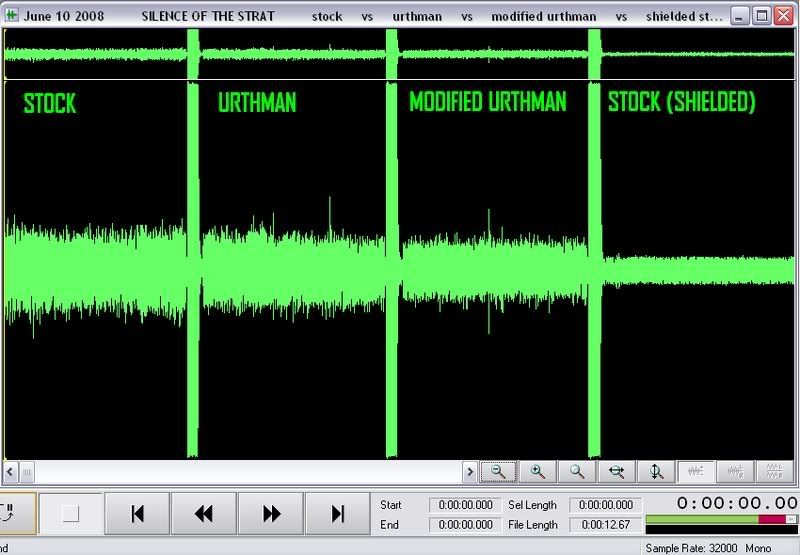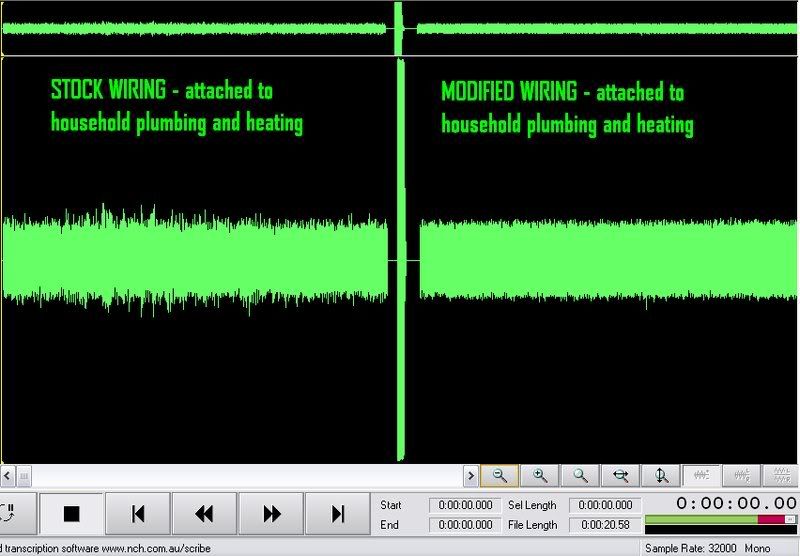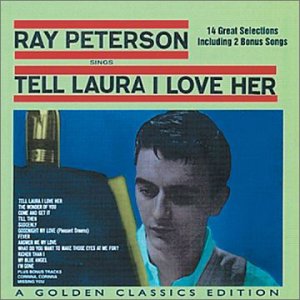Post by D2o on Jun 14, 2008 17:04:34 GMT -5
GN2 member ashcatlt came across this article:
urthman.jsent.biz/music/silence.html ,
in which it was suggested by it's author - and now GN2 member - urthman, that single coil pickups in a strat become antennae when one end of the pickup is disconnected by the switch - therefore picking up all sorts of ambient noise. Urthman seems to be suggesting that since one end of the disconnected pickup is still connected to the circuit, the inverse of the noise received by the disconnected pickups is then electrically pulled against the hot circuit and as a result the noise enters into the circuit, creating the unwanted noise.
He never actually states that he was able to eliminate the hum, as far as I can see, but certainly implies it.
We questioned urthman's contention - actually, that is being kind - and, despite some of us, me included, having fun at his expense, he was good enough to jump into the fray and defend his claim, and more than just imply that his suggestion works.
It is important to note that the author claims that this will reduce interference from such things as neon lights, fluorescent lights, and light dimmers. In other words, there is a possibility that the reason this wiring works well for the author is because he is playing in, "electromagnetically speaking", dirty environments.
Could there actually be something to this claim? There was only one way to find out.
We sourced out an inexpensive "Academy" brand strat, and set out to prove urthman's claim.
These tests were performed under conditions that were as controlled as I could make them. I plugged the same guitar into the same amp, with the same patch cord, with the volume set at 6, every time, so that the test would be easily comparable and repeatable, and the hum would be clearly audible. The following tests were performed with the guitar being held in the same position, angle, distance, etc. every time.
The first test was to record the stock unshielded strat, with the pickguard on.
The next test was to record the stock unshielded strat with the pickguard off.
The recordings were virtually identical.
The next step was to wire the guitar according to urthman's specifications:
OUT-GRD nnnnn BRI-GRD nnnnn MID-GRD nnnnn NEC-GRD
POLE nnnnnnnnn LUG nnnnnnnnn LUG nnnnnnnnn LUG
-----------------------------------------------------
s t r a t o c a s t e r s t y l e 5 w a y s w i t c h
-----------------------------------------------------
LUG nnnnnnnnnn LUG nnnnnnnnn LUG nnnnnnnnn POLE
BRI-HOT nnnnn MID-HOT nnnnn NEC-HOT nnnnn OUT-HOT
We batted around a few more ideas and tried a variation of urthman's wiring:
ALL3-GRD nnnnn OUT-GRD nnnnn OUT-GRD nnnnn OUT-GRD
POLE nnnnnnnnn LUG nnnnnnnnn LUG nnnnnnnnn LUG
-----------------------------------------------------
s t r a t o c a s t e r s t y l e 5 w a y s w i t c h
-----------------------------------------------------
LUG nnnnnnnnnn LUG nnnnnnnnn LUG nnnnnnnnn POLE
BRI-HOT nnnnn MID-HOT nnnnn NEC-HOT nnnnn OUT-HOT
At this point, we had recording of the stock strat with the pickguard on and off, as well as recording of the two variations of urthman's wiring, both with the pickguard off. We had enough basic data to draw some comparisons among the various wiring schemes - plus, we were now free to perform one last modification to the strat: stock wiring, but shield the guitar.
My conclusion is that there is a slight reduction in hum as a result of the urthman modification. It is not particularly noticeable to either the ear or the computer, but I don't think it is my imagination. In practical terms, however, I could not achieve the results you speak of - it is certainly not a sustantial or distinct reduction in hum, especially when compared to the final test - a stock guitar, but shielded - which produced a more noticeable reduction in hum.
Disclosure: The pickguard was not screwed on for the first three parts of the picture below, but proper shielding required that it be screwed down for the final part. However I did compare it to a previous recording of the unshielded stock guitar, with the pickguard also on, and it also produced similarly less hum there as well (in other words, before shielding, there was no significant difference in hum whether the pickguard was on or off).
The following illustrates the recordings, as compared side-by-side.

You can hear the signal comparison here - you may have to allow pop-ups in order to hear it:
media.putfile.com/Stock-v-Urthman-v-Modified-Urthman-v-Shielded-Stock
As a secondary experiment, I attached two 30' stranded wires to each of the ductwork and plumbing, respectively, in my house. With the stock wiring, it picked up a mish-mash of broadcasted noise (several radio stations, I believe ... ). With the modified wiring, it still picked up the broadcasts, although it seemed to pick them up to a far lesser extent than with the stock wiring.
It is important to note, however, that the change from stock to urthman wiring was not instantaneous, and by the time I got the modified wiring in place I could still hear broadcasted noise, but I was hearing talking instead of music, (would could account for it picking up "less" noise, if there was less to pick up).
In fact, I did not control the part of the experiment involving the source or type of broadcasted noise in question, it could have been anything that caused that reduction in noise. Nevertheless, there was less noise being picked up at the time that I used the modified wiring, for whatever reason.
The following illustrates the recordings, as compared side-by-side.

You can hear the signal comparison here - you may have to allow pop-ups in order to hear it:
media.putfile.com/Stock-vs-Urthman-with-plumbing-and-heating-attached
Again, It is important to note that the author claims that this will reduce interference from such things as neon lights, fluorescent lights, and light dimmers. In other words, there is a possibility that the reason this wiring works well for the author is because he is playing in, "electromagnetically speaking", dirty environments.
BOTTOM LINE:
If your guitar happens to be attached to a house, there may be some merit to urthman's idea, otherwise the "silence of the strat" modification did not deliver a material reduction in hum or other interference.
This could vary from guitar to guitar, etc., but shielding this guitar resulted in the least amount of hum.
For the entire sordid thread, click here: guitarnuts2.proboards45.com/?board=wiring&action=display&thread=3331&page=1
urthman.jsent.biz/music/silence.html ,
in which it was suggested by it's author - and now GN2 member - urthman, that single coil pickups in a strat become antennae when one end of the pickup is disconnected by the switch - therefore picking up all sorts of ambient noise. Urthman seems to be suggesting that since one end of the disconnected pickup is still connected to the circuit, the inverse of the noise received by the disconnected pickups is then electrically pulled against the hot circuit and as a result the noise enters into the circuit, creating the unwanted noise.
He never actually states that he was able to eliminate the hum, as far as I can see, but certainly implies it.
We questioned urthman's contention - actually, that is being kind - and, despite some of us, me included, having fun at his expense, he was good enough to jump into the fray and defend his claim, and more than just imply that his suggestion works.
The bottom line here is that my Strat, with my isolation wiring and NO additional shielding or clever gimmicks, running through a computer for signal processing (M-Audio Delta-1010 and AmpliTube 2), a Crown power amp and pair of really nice speakers is much less susceptible to neon lights and dimmers than my buddy's Charvel or Schecter running through his nice new Line-6 amp.
It is important to note that the author claims that this will reduce interference from such things as neon lights, fluorescent lights, and light dimmers. In other words, there is a possibility that the reason this wiring works well for the author is because he is playing in, "electromagnetically speaking", dirty environments.
Could there actually be something to this claim? There was only one way to find out.
We sourced out an inexpensive "Academy" brand strat, and set out to prove urthman's claim.
These tests were performed under conditions that were as controlled as I could make them. I plugged the same guitar into the same amp, with the same patch cord, with the volume set at 6, every time, so that the test would be easily comparable and repeatable, and the hum would be clearly audible. The following tests were performed with the guitar being held in the same position, angle, distance, etc. every time.
The first test was to record the stock unshielded strat, with the pickguard on.
The next test was to record the stock unshielded strat with the pickguard off.
The recordings were virtually identical.
The next step was to wire the guitar according to urthman's specifications:
OUT-GRD nnnnn BRI-GRD nnnnn MID-GRD nnnnn NEC-GRD
POLE nnnnnnnnn LUG nnnnnnnnn LUG nnnnnnnnn LUG
-----------------------------------------------------
s t r a t o c a s t e r s t y l e 5 w a y s w i t c h
-----------------------------------------------------
LUG nnnnnnnnnn LUG nnnnnnnnn LUG nnnnnnnnn POLE
BRI-HOT nnnnn MID-HOT nnnnn NEC-HOT nnnnn OUT-HOT
We batted around a few more ideas and tried a variation of urthman's wiring:
ALL3-GRD nnnnn OUT-GRD nnnnn OUT-GRD nnnnn OUT-GRD
POLE nnnnnnnnn LUG nnnnnnnnn LUG nnnnnnnnn LUG
-----------------------------------------------------
s t r a t o c a s t e r s t y l e 5 w a y s w i t c h
-----------------------------------------------------
LUG nnnnnnnnnn LUG nnnnnnnnn LUG nnnnnnnnn POLE
BRI-HOT nnnnn MID-HOT nnnnn NEC-HOT nnnnn OUT-HOT
At this point, we had recording of the stock strat with the pickguard on and off, as well as recording of the two variations of urthman's wiring, both with the pickguard off. We had enough basic data to draw some comparisons among the various wiring schemes - plus, we were now free to perform one last modification to the strat: stock wiring, but shield the guitar.
My conclusion is that there is a slight reduction in hum as a result of the urthman modification. It is not particularly noticeable to either the ear or the computer, but I don't think it is my imagination. In practical terms, however, I could not achieve the results you speak of - it is certainly not a sustantial or distinct reduction in hum, especially when compared to the final test - a stock guitar, but shielded - which produced a more noticeable reduction in hum.
Disclosure: The pickguard was not screwed on for the first three parts of the picture below, but proper shielding required that it be screwed down for the final part. However I did compare it to a previous recording of the unshielded stock guitar, with the pickguard also on, and it also produced similarly less hum there as well (in other words, before shielding, there was no significant difference in hum whether the pickguard was on or off).
The following illustrates the recordings, as compared side-by-side.

You can hear the signal comparison here - you may have to allow pop-ups in order to hear it:
media.putfile.com/Stock-v-Urthman-v-Modified-Urthman-v-Shielded-Stock
As a secondary experiment, I attached two 30' stranded wires to each of the ductwork and plumbing, respectively, in my house. With the stock wiring, it picked up a mish-mash of broadcasted noise (several radio stations, I believe ... ). With the modified wiring, it still picked up the broadcasts, although it seemed to pick them up to a far lesser extent than with the stock wiring.
It is important to note, however, that the change from stock to urthman wiring was not instantaneous, and by the time I got the modified wiring in place I could still hear broadcasted noise, but I was hearing talking instead of music, (would could account for it picking up "less" noise, if there was less to pick up).
In fact, I did not control the part of the experiment involving the source or type of broadcasted noise in question, it could have been anything that caused that reduction in noise. Nevertheless, there was less noise being picked up at the time that I used the modified wiring, for whatever reason.
The following illustrates the recordings, as compared side-by-side.

You can hear the signal comparison here - you may have to allow pop-ups in order to hear it:
media.putfile.com/Stock-vs-Urthman-with-plumbing-and-heating-attached
Again, It is important to note that the author claims that this will reduce interference from such things as neon lights, fluorescent lights, and light dimmers. In other words, there is a possibility that the reason this wiring works well for the author is because he is playing in, "electromagnetically speaking", dirty environments.
BOTTOM LINE:
If your guitar happens to be attached to a house, there may be some merit to urthman's idea, otherwise the "silence of the strat" modification did not deliver a material reduction in hum or other interference.
This could vary from guitar to guitar, etc., but shielding this guitar resulted in the least amount of hum.
For the entire sordid thread, click here: guitarnuts2.proboards45.com/?board=wiring&action=display&thread=3331&page=1









